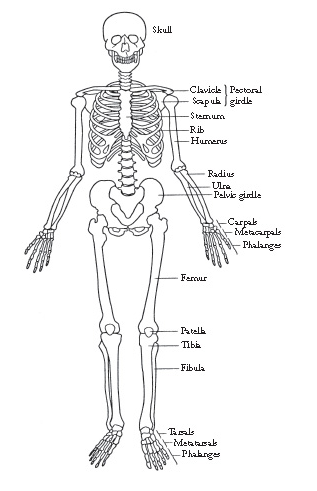Skeletons in Animals
Movement is one of the essential features of living things.
Cellular movement is observed in one-celled amoebas, ciliates, and flagellates.
Myofibrils Flagella whip about to produce cellular motion, while cilia beat synchronously to propel a cell.
In animals, movement is essential for locating food, escaping predators, and seeking mates.
In many animals, the movement process is centered in the muscle cell, which contracts and relaxes.
The contraction yields great force, which is applied against a surface by means of a skeleton.
Skeletal systems provide structure and protection for a variety of organisms.
A water-based skeleton provides the structure necessary for movement in worms.
The hard external skeleton (exoskeleton) not only provides a protective mechanism for many organisms but also assists in movement of insects.
The internal skeleton (endoskeleton) present in many animals provides the structural network for support, protection, and movement.
Hydrostatic skeleton
Many animals have a water-based skeleton, or hydrostatic skeleton.
Hydrostatic skeletons do not contain hard structures, such as bone, for muscles to pull against.
Rather, the muscles surround a fluid-filled body cavity.
In a worm, for example, movement occurs when muscle cells contract, and the contractions squeeze internal fluid (the hydrostatic skeleton) against the skin, causing the worm to stiffen and the body to shorten and widen.
The squirming motion of a worm also depends on a hydrostatic skeleton.
Exoskeleton
A second type of skeleton, the exoskeleton, exists in arthropods and mollusks.
In mollusks, the exoskeleton is a hard, protective outer covering.
An example is a clamshell; when a clam’s muscles contract, they close the shell rapidly, creating
In arthropods, the exoskeleton also provides protection and movement.
Usually, wings are attached by muscles in the hard body surface, which provides a foundation for the muscle contractions.
Muscle contractions raise and lower the wings, allowing flight.
Endoskeleton
Vertebrates have an internal skeleton called the endoskeleton, a framework of bones and cartilage the figure below that serves as a point of attachment for muscle.
The endoskeleton thus transmits the force of muscle contractions.
The endoskeleton also provides support for the body (for example, the legs) and protection (the skull).
Bone contains concentric rings of tissue in which bone cells called osteoblasts produce the inorganic materials (fibers and matrix) of bone.
Much of this material is calcium phosphate, formed from calcium and phosphorus delivered by the blood.
Living, mature bone cells called osteocytes are also located in the bone.
Bone-destroying cells called osteoclasts break down bone, thus providing a turnover of bone material needed in other areas. The combination of bone cells and bone tissue comprises a unit called a Haversian system.
Blood vessels and nerves also exist within the Haversian system.
Bones come together to form a joint, which may be immovable, such as in the sutures of the skull, or movable, such as in the joints of the elbow and shoulder.
In a movable joint, a capsule of synovial fluid provides lubrication.
Tough, fibrous tissues, known as ligaments, link bones to one another.
Connective tissues, called tendons, attach muscles to bones.

The Figure above shows The human skeleton showing the major bones of the body.
Scholarship 2026/27
Current Scholarships 2026/2027 - Fully Funded
Full Undergraduate Scholarships 2026 - 2027
Fully Funded Masters Scholarships 2026 - 27
PhD Scholarships for International Students - Fully Funded!
Funding Opportunities for Journalists 2026/2027
Funding for Entrepreneurs 2026/2027
***
